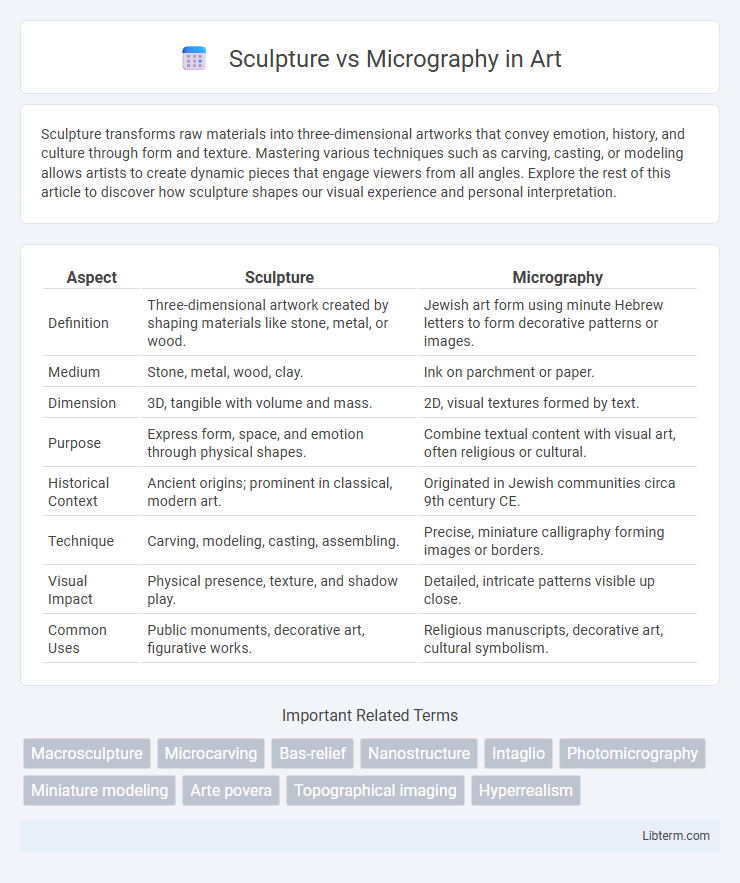Sculpture transforms raw materials into three-dimensional artworks that convey emotion, history, and culture through form and texture. Mastering various techniques such as carving, casting, or modeling allows artists to create dynamic pieces that engage viewers from all angles. Explore the rest of this article to discover how sculpture shapes our visual experience and personal interpretation.
Table of Comparison
| Aspect | Sculpture | Micrography |
|---|---|---|
| Definition | Three-dimensional artwork created by shaping materials like stone, metal, or wood. | Jewish art form using minute Hebrew letters to form decorative patterns or images. |
| Medium | Stone, metal, wood, clay. | Ink on parchment or paper. |
| Dimension | 3D, tangible with volume and mass. | 2D, visual textures formed by text. |
| Purpose | Express form, space, and emotion through physical shapes. | Combine textual content with visual art, often religious or cultural. |
| Historical Context | Ancient origins; prominent in classical, modern art. | Originated in Jewish communities circa 9th century CE. |
| Technique | Carving, modeling, casting, assembling. | Precise, miniature calligraphy forming images or borders. |
| Visual Impact | Physical presence, texture, and shadow play. | Detailed, intricate patterns visible up close. |
| Common Uses | Public monuments, decorative art, figurative works. | Religious manuscripts, decorative art, cultural symbolism. |
Introduction to Sculpture and Micrography
Sculpture is a three-dimensional art form that involves shaping materials such as stone, metal, or wood to create tangible figures or abstract designs. Micrography is a unique Jewish art form that uses minute Hebrew script to form intricate images and patterns, blending textual and visual art. Both techniques emphasize detail and craftsmanship but differ in medium and cultural origins.
Historical Evolution of Sculpture and Micrography
Sculpture dates back to prehistoric times, evolving through various cultures including Ancient Egyptian, Greek, and Renaissance periods, reflecting shifts in artistic techniques and religious symbolism. Micrography, emerging in 9th-century Jewish art, developed as a unique form of calligraphic decoration using minute Hebrew script to create intricate geometric and representational designs. Both art forms illustrate profound historical evolution, with sculpture emphasizing three-dimensional form and micrography highlighting textual artistry within visual compositions.
Core Techniques: Sculpture vs Micrography
Sculpture primarily involves carving, modeling, or assembling materials such as stone, metal, or clay to create three-dimensional forms, emphasizing texture, volume, and spatial presence. Micrography, a Jewish art form, uses intricate Hebrew calligraphy to compose detailed images or patterns, relying on precise penmanship and typography to form visual representations. Both techniques require meticulous attention to detail, but sculpture emphasizes physical manipulation of media, while micrography focuses on textual arrangement and fine motor control in two-dimensional space.
Materials Used in Sculpture and Micrography
Sculpture primarily utilizes materials such as stone, metal, wood, clay, and modern composites, each offering unique textures and structural properties that shape the artistic form. Micrography, a Jewish art form, employs ink on paper or parchment, where tiny calligraphic text or script creates intricate visual designs without traditional sculptural depth. The distinct choice of mediums directly influences the tactile and visual impact, with sculptures emphasizing three-dimensional physicality and micrography showcasing detailed, two-dimensional textual artistry.
Visual Impact: Three-Dimensional vs Text-Based Art
Sculpture captivates viewers through its three-dimensional form, offering tactile depth and dynamic shadows that engage multiple senses and perspectives. Micrography relies on intricate text-based patterns to create images, emphasizing detail and narrative within a two-dimensional plane. The visual impact of sculpture depends on spatial presence, whereas micrography draws attention to the precision and meaning embedded in its textual composition.
Artistic Purposes and Messages
Sculpture uses three-dimensional forms to convey artistic messages through physical presence, texture, and spatial interaction, often emphasizing themes like mythology, human emotion, or social commentary. Micrography, a Jewish art form, employs minute Hebrew script to create intricate images, blending textual meaning with visual representation to deliver religious, cultural, or philosophical messages. Both mediums communicate complex narratives, but sculpture prioritizes tactile and visual impact while micrography integrates linguistic and artistic expression.
Cultural Significance and Symbolism
Sculpture embodies cultural significance through its three-dimensional representation of historical figures, myths, and religious icons, often symbolizing power, spiritual beliefs, and societal values. Micrography, originating from Jewish tradition, utilizes minute Hebrew text to create intricate images, merging religious devotion with artistic expression and symbolizing the fusion of language and visual art. Both art forms serve as cultural artifacts, preserving identity and heritage while conveying complex symbolic meanings within their respective communities.
Notable Artists in Sculpture and Micrography
Notable artists in sculpture include Auguste Rodin, whose expressive forms revolutionized modern sculpture, and Louise Bourgeois, known for her large-scale installations exploring themes of family and memory. In micrography, a unique Jewish art form, artists like Yitzhak Nahem and Yehuda Morad have pioneered intricate designs combining Hebrew calligraphy with detailed imagery. Both disciplines showcase distinct approaches to form and detail, with sculpture emphasizing three-dimensional physicality and micrography blending script with visual art.
Contemporary Innovations in Both Art Forms
Contemporary innovations in sculpture emphasize sustainable materials, interactive installations, and digital fabrication techniques such as 3D printing, enabling artists to explore new textures and forms. Micrography integrates advanced tools like high-resolution imaging and precision lasers to enhance detail and scale, pushing the boundaries of traditional text-based art. Both art forms increasingly intersect with technology and multimedia, transforming how audiences engage with physical and visual narratives.
Choosing Between Sculpture and Micrography
Choosing between sculpture and micrography depends on the desired artistic expression and medium complexity. Sculpture offers tactile, three-dimensional form and material versatility, ideal for physical spatial interaction, while micrography emphasizes intricate, text-based detail, blending visual art with literary content on a flat surface. Artists must consider their focus on tactile versus textual detail and the spatial impact they want to achieve in their artwork.
Sculpture Infographic

 libterm.com
libterm.com